The Gossip Girl Reboot's Prep School Uniforms Are a Perfect Evolution of Its Iconic Aughts Attitude
EntertainmentTV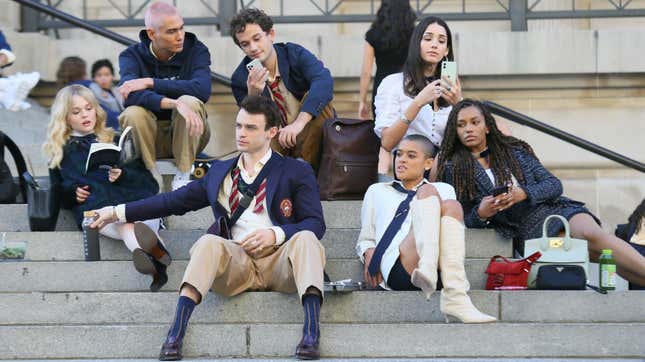

Gossip Girl was many things: scandalous, gruesome, petty, confusing, badly paced, and often poorly acted. It existed at the axis of an online changing of the guard, out of the ‘aughts conservatism that came to define cable television, and into a world where teens who railed coke shocked most slightly less than it would have a decade prior. The CW drama, in many ways, also hailed the advent of teens with cell phones, who could easily access their online lives as easily as they could their everyday ones. And for a brief five years, it was one of the most beloved (and, for a generation that saw itself reflected in it, hated) shows on television.
For a kid in a small farm town, there was nothing either relatable or familiar about the show’s New York City setting, or the clothes of its inhabitants, who would regularly attend school functions wearing Marc Jacobs or Diane Von Furstenberg or Moschino or then-upcoming atelier Elie Saab. I’d only ever worn a uniform to class in elementary school in the backyard of the local church. But where the denizens of Gossip Girl’s Upper East Side wore tailored suits and expensive, crocodile leather loafers to class, I lived through the era in hole-ridden slacks and itchy polos that were thrifted, and made of a starchy polyester that smelled like cotton balls.
Everything about Gossip Girl was unfamiliar, except for the actual human beings who populated it. Despite the accoutrements, the adults-playing-teens felt familiar to me. Mostly in their engagement with the burgeoning online culture around them. In turn, that shaped the way I, and others of my cohort, interacted via text, or on Tumblr. It was an evolution of gossip, and online identity, unlike anything else seen before it.
Thirteen years have passed since Gossip Girl premiered in 2007. I was in middle school at the time and addicted to the online messaging board for celebrity gossip, Oh No They Didn’t!. The LiveJournal-based hub for celebrity culture, which came to define the tone and tenor of the burgeoning celebrity blogging industry, was a perfect hub of operations for Gossip Girl’s soon-to-be fanbase. With a cast of young, hot 20-somethings amid rumors of on-set romances and love triangles, it didn’t take long for the board to obsessively track the likes of Leighton Meester or Penn Badgley or Chace Crawford, a man lovingly emblazoned on the binders of most girls in my class. The show thrived because of its growing online fanbase, and was shaped by it.
Now, HBO is reimagining the show for a new generation, and the old one too, I guess. Yesterday, pictures were posted from the set, featuring a cast of predictably hot and lithe young people of indeterminate age, projecting an instant “coolness.”

Unlike its predecessor, the reboot looks noticeably less white, which is a refreshing update to a show that almost exclusively documented the ennui of WASP-y heiresses. The costumes are also more streamlined, and focused, than the slapdash sartorial choices of the former, which came to encompass a broad stroke of ill-remembered trends: headbands, houndstooth and tartan, slingback sandals and red-bottom stilettos. And instead of coiffed balayages or perfectly curled, waist-length tresses, the cast sports looks that run almost in opposition to what the original stood for. Jordan Alexander, a main character, has a shaved head, as does skater Evan Mock, whose buzzcut remains dyed in his signature pink.
Its prep uniforms have also been updated, but retain the identifiable quality of their blueprints. Through its fashion choices, Gossip Girl made clear the intentions of its characters. Blair Waldorf wore uptight, tweed skirt suits and princess dresses with bows in her hair, because she was at once the ruler of the Constance Billard School for Girls, and in training to take over her mother’s fashion line. Serena Van Der Woodsen’s unbuttoned blouses, messy blowouts, and loose ties were the byproduct of her rebellious spirit and incessant need to show off and stand out from her peers after returning from boarding school. As she re-acclimated to life on the UES, she began to adopt more of Blair’s signature styles, signaling that there was a war for power brewing between the two.
Those unbuttoned blouses of Serena’s were also a parallel to her primary love interest in early seasons, Nate Archibald, who also wore his shirts unbuttoned and slacks wrinkled with a messy mop of hair just barely obscuring his eyes. The echoes of these overt characterizations are reflected in the newer cast. The below outfit is a direct nod to Nates’s look in Season 1, back in 2007. But where his slacks reflected the business-minded ambitions of students at St. Jude’s for Boys, Eli Brown wears wrinkled cargo shorts, reflective of more contemporary, preppy trends. Even St. Jude’s blazer has undergone a welcome update, with costume designers showing the evolution in trends through both the textile and a short breasted collar, rather than the original’s wide-breasted, almost trench-like blazers.
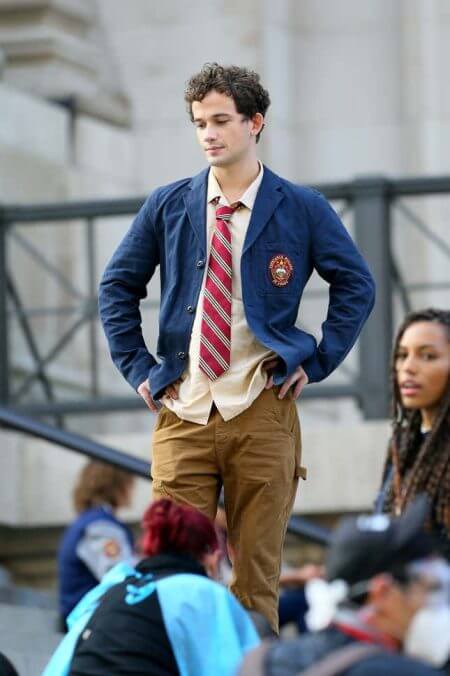
Evan Mock’s outfit, meanwhile, reads like the successor to Dan Humphrey’s early years on the show—a loner at St. Jude’s, a fish out of water who stuck out in his civilian clothes and earth-toned utility jackets. It’s also nice to see that St. Jude has eased its clothing restrictions—imagine a single character on the original Gossip Girl wearing a sweatshirt. It’s unimaginable! But in the decade since the original, sweatshirts have quickly become a status symbol, thanks to brands like Champion and its streetwear affiliates driving up the price.
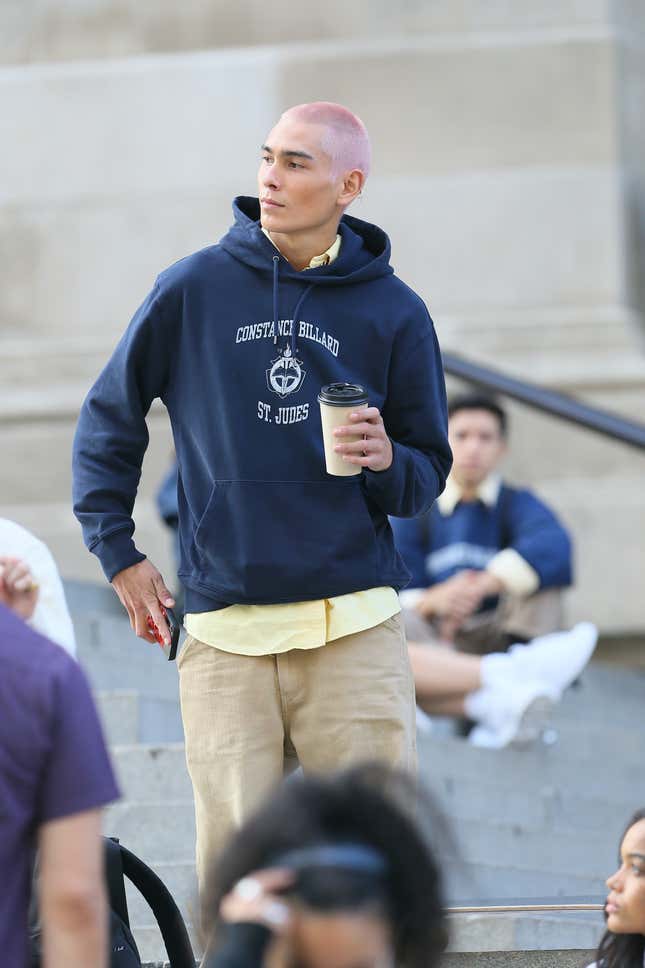
Savannah Smith, meanwhile, rocks a tweed suit that is shockingly similar to Blair Waldorf’s signature style. But where Blair rocked the pearls on her headbands, costume designers have migrated that to the choker around Smith’s neck—which I would argue exists in place of the headband of yesteryear. They’ve also updated her blouse with a crop, which even the luxurious house of Chanel has updated in the waning years of Lagerfeld’s reign. Yet still, the look retains its regalness, and impact. My favorite touch is the platformed Gucci Mary Janes, in crocodile print, of course. (And I absolutely spotted the Birkin perched right behind her.)
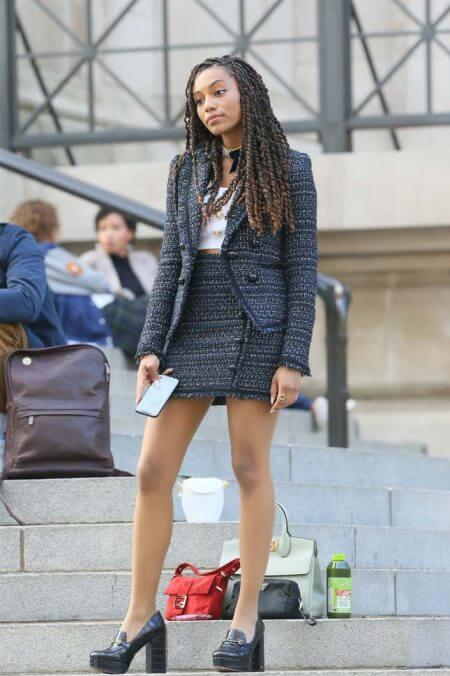
Zion Moreno is perhaps the most “basic” of the showcased looks. With the miniest of mini-skirts and a sock and mule combo worn in excess by the Parisian fashion press, it’s an outfit I would normally abhor. But here it works. She is clearly a character who chases trends, more than her peers. She’s obviously wealthy, too, and styled like a very popular person who believes herself to be above strict dress code rules, even if she is a follower to her classes true supreme—from the looks of it, Savannah Smith’s character.

And while I don’t have a proper full-body shot, I do want to take one brief moment to commend the costume department on Jordan Alexander’s ensemble, the most “Serenalike” of the group, with a loose tie and masculine-cut shirt—however outdated that term might be. It makes the nu-cowboy boots, identified as Schutz by eagle-eyed fashion people on Twitter, that much more exciting. These are costume designers who understand the spirit of the original, and can accurately translate it to an entirely different era in fashion, without appearing gimmicky. It isn’t an easy note to balance!
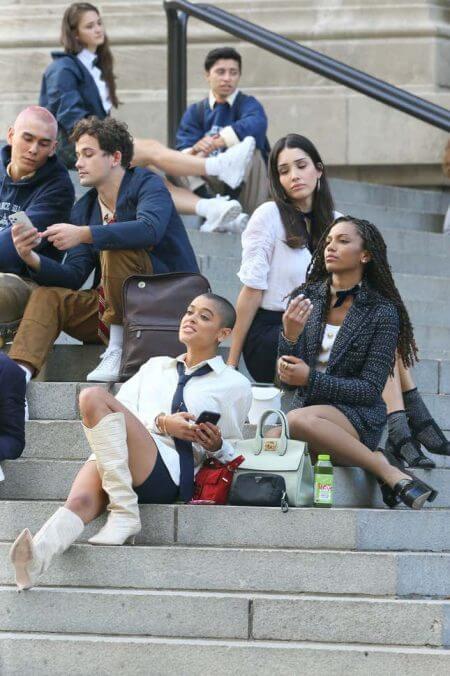
Ten years on, I believe the popular revulsion to Gossip Girl, more than any other teen drama of its ilk save Riverdale, exists as a byproduct of my generation’s collective anxiety about the mirror it held up to our early days online. Where most teen dramas cast high school in the early ’10s as a frontier for burgeoning identities and a freeing of past social strictures, Gossip Girl maintained that the pettiness, the infighting, and the gossipy nature of young people was exacerbated by the introduction of the internet, and often not for the better. I recognized myself and my friends in Gossip Girl’s text blasts, and the ways in which texting became the primary vehicle for social relationships. Sure, teens like me were freer to do what we wanted, say what we wanted, and dress how we wanted, but we also had to contend with social lives in a multitude of spaces, both tangible and intangible, that revealed the worst qualities about ourselves.
And still, for all its trappings, Gossip Girl stands at the peak of teen television, a status greatly aided by its spectacular costume design, however poorly it might have aged since everyone collectively ditched headbands for chokers and waist-length blowouts for buzzed heads. From the looks of it, the costume designers on the reboot know exactly what they’re doing. I couldn’t be more excited.